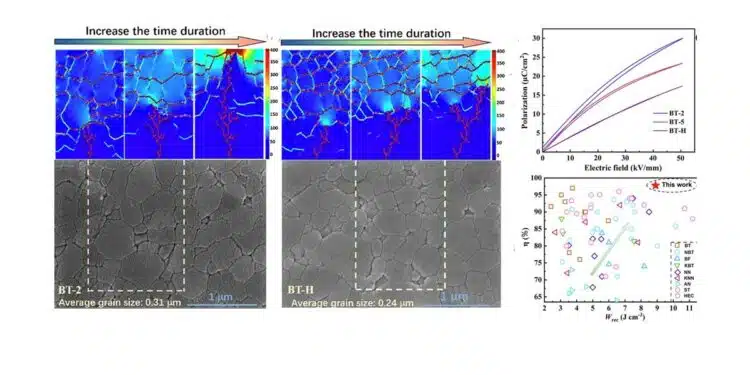Researchers from Shanghai, China published paper in Nature Communications Journal that explores a high-entropy engineering strategy applied to relaxor ferroelectric ceramics, specifically transforming BT-Bi(Mg0.5Zr0.5)O3 into BT-H through dual-phase cationic disorder modulation.
The result is a material with exceptional energy storage performance and thermal resilience.
Introduction
Dielectric ceramic capacitors are vital components in modern electronics due to their high power density and rapid charge/discharge capabilities. However, achieving both high energy density and ultrawide temperature stability remains a challenge.
Key Points
- High-entropy ceramics (BT-H) achieve 8.9 J/cm³ recoverable energy density.
- Conversion efficiency reaches 97.8% with minimal hysteresis.
- Stable performance across −85°C to 220°C with ±9% energy variation.
- Atomic-scale disorder and multiphase coexistence enhance dielectric properties.
1. High-Entropy Strategy and Material Design
The BT-H system is derived by substituting the B-site cations in BT-BM with a cocktail of five elements (Mg, Zn, Al, Sn, Zr) and introducing NaTaO3. This increases the configurational entropy (Sconfig) and promotes atomic-scale polar inhomogeneity. The coexistence of multiple perovskite phases (orthorhombic, rhombohedral, tetragonal, cubic) facilitates smoother energy transitions and reduces hysteresis.
2. Microstructure and Breakdown Strength
SEM analysis reveals compact grain structures with reduced grain size from 0.31 μm to 0.23 μm. This refinement enhances breakdown strength (Eb) due to suppressed grain boundary migration. UV-vis spectroscopy shows an increased bandgap (Eg = 3.38 eV), indicating improved intrinsic breakdown resistance.
| Sample | Grain Size (μm) | Bandgap (eV) |
|---|---|---|
| BT-2 | 0.31 | 3.12 |
| BT-H | 0.23 | 3.38 |
3. Dielectric and Relaxor Behavior
BT-H ceramics exhibit relaxor ferroelectric behavior with a modified Curie–Weiss slope γ > 1.5. The transition temperature Tm shifts below room temperature, indicating a superparaelectric (SPE) state. This state minimizes dipolar interactions and hysteresis, enhancing energy efficiency.
4. Energy Storage Performance
Unipolar P-E loops show needle-like shapes with near-zero remanent polarization (Pr < 0.4 μC/cm³). Under 83.3 kV/mm, BT-H achieves:
| Sample | Wrec (J/cm³) | η (%) |
|---|---|---|
| BT-2 | 6.0 | 92.1 |
| BT-H | 8.9 | 97.8 |
The energy density increases linearly with electric field, while Pr remains low, confirming entropy-induced suppression of long-range polar domains.
5. Temperature Stability and Raman Analysis
BT-H maintains stable polarization and efficiency across −85°C to 220°C. Raman spectra show minimal shifts in Ti-O bond modes, indicating robust thermal stability of polar configurations.
| Temperature (°C) | ΔWrec (%) | Δη (%) |
|---|---|---|
| −85 to 220 | ±9 | ±4.8 |
6. Atomic-Scale Structure and Phase Coexistence
HAADF-STEM imaging reveals disordered oxygen octahedral tilts and multiphase coexistence. The polarization vector mapping shows a predominance of tetragonal phase (61.7%), with rhombohedral and orthorhombic phases contributing to local heterogeneity.
7. Phase-Field Simulation and Theoretical Validation
Simulations confirm that domain sizes remain below 5 nm and exhibit minimal temperature dependence. The Ginzburg–Landau equation governs polarization evolution:
This supports the observed near-zero hysteresis and stable energy storage behavior across extreme conditions.
Conclusion
The BT-H high-entropy relaxor ferroelectric ceramics represent a breakthrough in dielectric energy storage. Through entropy engineering, they achieve high energy density, ultrahigh efficiency, and exceptional temperature stability. These properties make BT-H a promising candidate for capacitors in electric vehicles, aerospace, and high-precision electronics operating under extreme conditions.
Read the complete paper:
Zhou, S., Zhou, Y., Li, L. et al. Ultrawide-temperature-stable high-entropy relaxor ferroelectrics for energy-efficient capacitors. Nat Commun 16, 8456 (2025). https://doi.org/10.1038/s41467-025-63173-z































